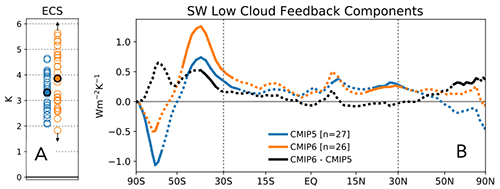Latest Earth System Models predict more global warming than their predecessors
The severity of climate change is closely related to how much the Earth warms in response to increased greenhouse gas concentrations. A commonly used measure of this is the equilibrium climate sensitivity (ECS) – the global surface temperature response to an abrupt doubling of atmospheric carbon dioxide (CO2). Estimates of ECS have historically centered on a warming of 3˚C for a doubling of CO2, with the most recent United Nations Intergovernmental Panel on Climate Change (IPCC) report deeming ECS to be likely between 1.5 and 4.5˚C. It has been a stubborn challenge for the scientific community to narrow this range.
Several techniques have been used to estimate ECS. One can infer it from instrumental measurements of how much the Earth has warmed as greenhouse gas concentrations have increased over the past 100-150 years. Alternatively, one can use proxy evidence of ancient warm or cold climates like the last Ice Age roughly 20 thousand years ago or the mid-Pliocene Warm Period roughly three million years ago. Another method is to assess the warming from doubled or quadrupled CO2 levels in an Earth System Model. Such experiments are routinely done as part of the Coupled Model Intercomparison Project (CMIP), which is now in phase 6.
In this study, Zelinka and coauthors compared ECS values derived from CO2 quadrupling experiments conducted with 27 CMIP6 models that were available at the end of November 2019 with values from all 28 models from the previous (CMIP5) generation. The latest models have wide-ranging sensitivities spanning values of 1.8 to 5.6˚C, but taken as a whole, they warm more than their predecessors by about 0.5˚C. Ten of the models now have sensitivities exceeding 4.5˚C, outside the aforementioned IPCC “likely” range.

Figure 1 (A) Estimates of effective climate sensitivity (ECS) for individual (blue) CMIP5 and (orange) CMIP6 models. Multi-model averages are shown with filled markers. (B) Zonally averaged multi-model average shortwave low cloud feedbacks. CMIP6-CMIP5 differences are shown in black lines, which are solid where differences are significant at 95% confidence. Click image to enlarge.
The primary culprit for the enhanced warming was shown to be clouds. Specifically, both the water content and the areal coverage of low-level clouds decrease more strongly with greenhouse warming in the latest models, causing enhanced planetary absorption of sunlight – an amplifying feedback that ultimately results in more warming. This stronger amplifying cloud feedback is particularly dramatic over the Southern Ocean (Figure 1). The authors showed that differences in the physical representation of clouds drive this enhanced sensitivity relative to the previous generation of models. That is, differences between CMIP5 and CMIP6 in how cloud properties respond to their environment – not in how their environments change – leads to a more positive cloud feedback in CMIP6.
An important question is whether these latest models with amplifying Southern Ocean cloud feedbacks are more trustworthy. At least one aspect of the latest models has improved: their mix of liquid droplets and ice crystals in clouds. For years, models have failed to match observations in maintaining abundant liquid water at temperatures well below freezing. But the latest models are keeping more cloud water in this “super-cooled” liquid phase, an improvement that has previously been shown to increase climate sensitivity. Taken alone, this improvement might suggest that these highly sensitive models are giving us a more realistic view of future warming.
But a broader view is needed. By improving certain aspects of the models, other imperfections may have been introduced or unmasked, and there are some indications that several high sensitivity models poorly simulate the observed global warming rate over the last few decades. Only after fully vetting these models against the best available observations can we start making conclusions about whether Earth has more warming in store than originally thought.
Causes of Higher Climate Sensitivity in CMIP6 Models (Geophysical Research Letters)
Topics
- Southern Ocean
- Modeling
- Climate Change
